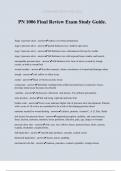©THEBRIGHTSTARS 2024
PN 1006 Final Review Exam Study Guide.
Stage 1 pressure ulcer - answer✔redness over bony prominence
stage 2 pressure ulcer - answer✔partial thickness loss, shallow open ulcer
stage 3 pressure ulcer - answer✔full thickness loss, subcutaneous fat may be visable
stage 4 pressure ulcer - answer✔full thickness loss with exposed bone, tendon, and muscle
unstageable pressure ulcer - answer✔full thickness loss, base of ulcer covered by slough,
eschar, or both in wound bed
wound exudate - answer✔describes amount, colour, consistency of wound and drainage odour
slough - answer✔soft yellow or white tissue
eschar - answer✔black or brown necrotic tissue
contracture - answer✔deformity resulting from stiffness/constriction in connective tissue;
develops when tissue becomes less flexibe
varicella - answer✔chicken pox; infectious viral disease. Use airborne precautions
sims position - answer✔left side lying, right hip and knee bent
braden scale - answer✔lower score indicates higher risk of pressure ulcer development. Patients
with a score of 16 or less are considered to be at risk of developing pressure ulcers
nutrients needed for wound healing - answer✔calories, proteins, vitamin C, A, E, Zinc, fluids
risk factors for pressure ulcers - answer✔impaired perception, mobility, and consciousness,
shear, friction, moisture, nutrition, tissue perfusion, infection, pain, age, impact of wounds
pressure ulcer sites - answer✔chin, ears, toes, elbows, knees, posterior knee, heels, sacrum,
scapula, trochanter, occipital bone,
full liquid diet - answer✔smooth dairy products, custards, cooked cereal
thickened liquid diet - answer✔nectar, honey, pudding
mechanical soft diet - answer✔bananas, pancakes, cooked vegetables, cottage cheese
, ©THEBRIGHTSTARS 2024
soft/low residue diet - answer✔low fibre, easily digested; pasta, tender meat, canned/cooked
fruits and vegetables
low sodium diet - answer✔limited to max 4g of sodium, minimum of 500 mg
low cholesterol diet - answer✔less than 200mg/day of cholesterol
diabetic diet - answer✔decrease total fat to less than 30% of calories
what do you do if you are exposed to blood - answer✔wash exposed skin and cuts with soap
and water, if area is around eyes, nose, and mouth flush with water, immediately report, seek
evaluation from health care professional
vesicular lung sounds - answer✔soft, breezy, low-pitch, inspiration lasts 3x longer that
expiratory phase
bronchovesicular lung sounds - answer✔blowy, medium-pitch, inspiration equal to expiration
bronchial lung sounds - answer✔loud, high-pitch, hollow; expiration longer than inspiration
(3:2 ratio)
crackle lung sounds - answer✔high-pitched, fine, short, interrupted crackling sound
rhonchi lung sounds - answer✔loud, low-pitch, rumbling, coarse sounding
wheeze lung sounds - answer✔high-pitched, musical, sounds like a squeak
pleural friction rub sounds - answer✔dry, rubbing, grating
the output that comes from a stoma - answer✔effluent
ileostomy location - answer✔ileal portion of small intestine
effluent from an ileostomy - answer✔watery-thick, containing digestive enzymes
colostomy location - answer✔large intestine - ascending, transverse, descending, sigmoid
effluent from a colostomy in the ascending and transverse quadrant - answer✔thick liquid to
semi-formed stool
effluent from a colostomy in the descending or sigmoid quadrant - answer✔similar to what is
normally passed through the rectum
urostomy - answer✔resected portion of ileum; ureters implanted through mucosa and the other
end brought through the abdominal wall
hypercalcemia - answer✔caused by immobility; calcium is released into blood stream




